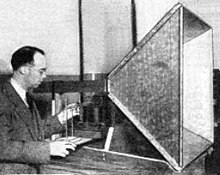Wilmer L. Barrow
Wilmer L. Barrow | |
|---|---|
 Barrow with the first horn antenna | |
| Born | July 26, 1903[1] Baton Rouge, Louisiana, U.S. |
| Died | August 29, 1975 (aged 72)[2] |
| Alma mater | Technical University of Munich |
| Awards | IEEE Edison Medal (1966) |
| Scientific career | |
| Doctoral students | Lan Jen Chu |
Wilmer Lanier Barrow (July 26, 1903 – August 29, 1975) was an American electrical engineer, inventor, teacher, industrial manager, and a counselor to government agencies.[3] He obtained a BSEE degree in 1926 from Louisiana State University, and a doctorate from the Technical University of Munich in 1931.[4] During the pre-World War 2 development of radar at Massachusetts Institute of Technology, Barrow performed research on microwaves, inventing waveguide in 1936 and the horn antenna in 1938.[5]
He was vice president for research, development and engineering of the Sperry Rand Corporation.
He was elected to the grade of Fellow in the IEEE in 1941, and a Fellow of the American Academy of Arts and Sciences in 1942.[6] In 1943 he received the IEEE Morris N. Liebmann Memorial Award In 1966 he received the IEEE Edison Medal.
References
- ^ "IRE Directory". 1960.
- ^ "Wilier Barrow of Sperry Dead". The New York Times. August 31, 1975.
- ^ "Wilmer Barrow". IEEE Global History Network. IEEE. Retrieved July 25, 2011.
- ^ IRE Directory. Institute of Radio Engineers. January 1, 1960.
- ^ Packard, Karle S. (September 1984). "The Origin of Waveguides: A Case of Multiple Rediscovery" (PDF). IEEE Transactions on Microwave Theory and Techniques. MTT-32 (9). Inst. of Electrical and Electronic Engineers: 961–969. Bibcode:1984ITMTT..32..961P. doi:10.1109/tmtt.1984.1132809. Retrieved March 24, 2015.
- ^ "Book of Members, 1780–2010: Chapter B" (PDF). American Academy of Arts and Sciences. Retrieved May 17, 2011.